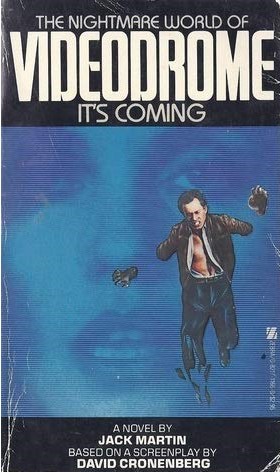 By JACK MARTIN (Zebra Books; 1983)
By JACK MARTIN (Zebra Books; 1983)
Yes, this is a movie novelization, and yes, it does suffer from quite a few of the pratfalls afflicting most such books: it’s hastily written and definitely could have withstood another draft, if not two or three. Overall, however, it’s far better than the majority of movie novelizations I’ve read, which really shouldn’t be surprising considering that the film VIDEODROME, written and directed by the inimitable David Cronenberg, is an extremely good one, and the author of this book, Dennis Etchison (using his “Jack Martin” pseudonym, as he did with his HALLOWEEN II and III novelizations) is no slouch himself.
Dennis Etchison’s short stories (collected in THE DARK COUNTRY, RED DREAMS, THE BLOOD KISS and THE DEATH ARTIST) or novels (DARKSIDE, SHADOW MAN, CALIFORNIA GOTHIC) all readily attest that he’s a genre specialist of unique power and originality. He’s dubbed this book and his other novelizations compromises, admitting, “I did the best job I possibly could with them; I had to eat”.
David Cronenberg, for his part, should need no introduction. Having created freaky cinematic masterworks like SHIVERS, RABID, DEAD RINGERS and CRASH, he’s the king of “bodily horror,” specializing in elegant, sophisticated and deeply subversive films about disease, madness and mutation. VIDEODROME is a sterling entry in Cronenberg’s ouvre, being the wildly surreal, gory and outrageous story of a sleazy cable TV operator’s descent into a hallucinatory world via a malignant TV signal. The film’s imagery, which includes a vaginal slit that appears in the protagonists’ chest and a gun with tendrils that burrow into its user’s arm, is weird enough to offer any prospective novelist a near-insurmountable challenge. This is particularly true with Etchison, a writer who specializes in “quiet” horror but who’s called upon here to transcribe a number of singularly gruesome sights. As you might expect, the screen-to-page transition is not always a smooth one, as evinced by the oft-perfunctory nature of Etchison’s descriptions
Where Etchison excels is in his superbly rendered atmosphere of hallucinatory dread, which is even more vividly evoked here than in the film. The protagonist Max Renn, who’s in every scene, is likewise extremely vivid and well characterized; despite his sleazy nature, I actually came to like the guy, and felt bad for him as he descended ever further into madness.
What the author can’t do is make much sense of the story, which was a jumble in the film and remains so on the page (there’s a sort of virtual reality helmet Max puts on halfway through, and Etchison insists on periodically reminding us that he’s still wearing the thing even though the action never jells with that claim). That’s doubtless due to the fact that the script was regularly reworked during shooting. Cronenberg reportedly invited Etchison up to the Toronto set and generously answered all his questions, meaning that at the very least the book follows the film’s actions fairly closely and even includes a few bits that don’t show up onscreen (such as a monster television set that rises up from a bathtub).
Overall, VIDEODROME the novel is certainly no masterpiece, but remains an interesting concoction nonetheless. I’d definitely recommend seeing the film first, but you’d also do well to check out this book, which may surprise you with its grace and fluidity. It certainly surprised me.
